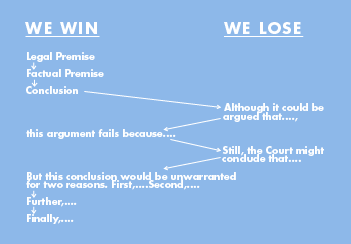What is the meaning of the word, “dialectic?”
To the Greek philosopher Plato, it was akin to a dialogue, and closely associated with the Socratic method. He saw it as a medium for arriving at the truth. And that is largely how we view it today. When we organize an argument dialectically, we follow the three-step format that the German philosopher Hegel used for resolving a paradox (a seemingly self-contradictory statement or proposition):
Begin by presenting a clearly delineated concept (thesis), and then move to its opposite (antithesis). End by explaining the synthesis—that is, the resolution, or truth, of the matter.
When writing a motion or opening brief, organize your legal argument section dialectically by beginning and ending with the points in your favor, and anticipating and rebutting the counterarguments in the middle. Lay out the pros and cons on each side, and then explain why the balance should tip in your favor.
Use the same format to acknowledge the apparent “bad facts,” and then explain why they are not fatal to your case, or better yet, actually strengthen it. When you ignore the contrary evidence, you risk appearing dishonest.
Address only the most obvious opposing arguments at this juncture. There’s no need to offer up weaknesses in your argument that the other side likely hasn’t thought of yet, nor is it wise to do so.
Also, do not expend too many words setting out the points against your argument before you counter them. As legal writing expert Bryan Garner says, “Your undercut needs to be swift and immediate.”
Here is a handy chart from Garner’s The Winning Brief, 3d ed.:

Organizing your arguments dialectically will increase your power of persuasion for a few reasons. First, thinking through the opposing arguments will force you to strengthen your own. Second, acknowledging the weak points that you know will occur to the judge or clerk—will increase your credibility. And third, dealing with the counterpoints in the middle of the argument will help ensure that they make neither the first nor the last impression.
The following example from The Winning Brief is poorly structured, because it showcases the opponent’s argument:
[Opponent’s] first substantive argument is that he is entitled to a jury trial on whether he agreed to arbitrate employment disputes with [client] because (A) he allegedly did not realize that his Form U-4 contained the arbitration clause appearing immediately above his final signature, and (B) [client] defrauded him by not directing his attention to the U-4’s arbitration clause. [citation]. That argument ignores basic principles of arbitration and contract law, and it has been overwhelmingly rejected by courts that have considered these arguments in nearly identical circumstances. In fact, [judge and court] rejected [opponent’s] exact arguments earlier this month:
[block quote]
[citation].
Here is the same argument structured as a dialectic—as presented by Garner:
The arbitration agreement for employment disputes is fully enforceable. Although [opponent] argues that he is entitled to a jury trial on whether he agreed to arbitrate with [name of client], he ignores basic principles of arbitration and contract law. His twofold contentions are (1) that he did not realize that his Form U-4 contained the arbitration clause appearing immediately above his final signature, and (2) that [client] defrauded him by not directing his attention to the U-4’s arbitration clause. [citation]. Contentions like these have never succeeded in other cases. And in the federal companion case to this one, [judge and court] rejected [opponent’s] exact arguments earlier this month:
[block quote]
[citation].
This Court should not accept [opponent’s] invitation to disturb the settled law.
Why does this version of the argument sound more convincing? It starts with counsel’s point and ends with a forceful reassertion of the position, while playing down the opponent’s argument by placing it in the middle and casting it in a dependent clause (Although …).
About the author:
Attorney Savannah Blackwell is a former news reporter who covered government and politics for more than a decade, mostly in San Francisco. She can be reached at savannah.blackwell@gmail.com. Follow her on Twitter at @SavannahBinSF


